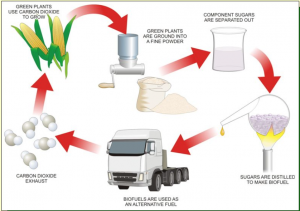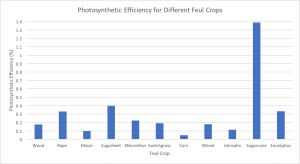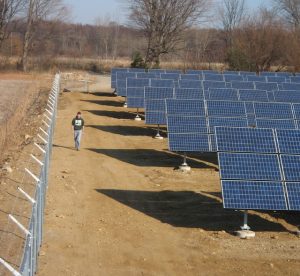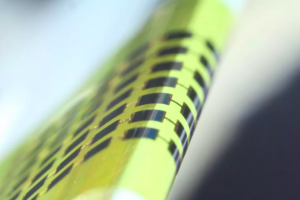Agitation regarding rising greenhouse emissions and petroleum costs has drawn focus to biofuels as renewable source of transportation fuel. However, a study published in Angewandte Chemie argued that crops should not be harvested for biofuel due to their reduced photosynthetic efficiency (percent light converted to stored energy) and annexation of agricultural land from food plants.
Biofuels require a massive energy input espoused as transportation costs, fertilizer production and agriculture machinery that amounts to 50% of the energy that biofuels contain. The energy investment is extricated from fossil fuels, leading scientists to believe that the net reduction in carbon dioxide emissions from biofuel production is marginal.
Moreover, repurposing arable land for fuel crop harvest will decrease food production thereby inflaming food prices.
Alternative renewable energy such as photovoltaic cells, which are used to generate solar power, are 150 times more efficient at harnessing energy than plants. Moreover, combustion engines powered by biofuels have 20% thermal efficiency compared to electrical engines, which utilize 80% stored chemical energy in batteries.
Hence, harnessing solar generated electricity to charge electric cars is found to optimize land usage 600 times more efficiently than producing biofuels to power internal combustion engines.

The Biofuel Lifecycle Credit source: Wikipedia
Biomass differs from other renewable sources since its energy is stored as chemical bonds in carbohydrates that are broken down to ethanol to power cars.
Photosynthetic pigments in plants absorb light, and electrons and protons (negatively and positively charged particles) transfer the radiant energy to reactor centres. Subsequent reactions synthesize ATP, a biological energy carrier, which assimilates carbon dioxide from the air and converts it to carbohydrate.
As a result of biological inefficacies in electron movement, limited reaction rates, and maximal sunlight absorption of 20% by photosynthetic pigments, only 1% photosynthetic efficiency is observed for most plants. Using the yield of biofuel per unit area of land, the photosynthetic efficiency was calculated for various fuel crops.

Photosynthetic Efficiency for Different Fuel Crops Data Source- Sustainable Energy – without the hot air
Given that biomass is a source of carbon, researchers believe that biomass is best utilized for manufacturing chemicals that are synthesized from petroleum. Leftover plant residues and compost can be used for generating heat and electricity.
Planting trees would fix 2.7 kg of carbon dioxide per square meter,whereas biofeuls with 1% photosynthetic efficiency would produce 0.31 kg of carbon dioxide per square meter when combusted.
Sarrah Putwa
References
Vennestrøm, P. N. R., Osmundsen, C. M., Christensen, C. H. and Taarning, E. (2011), Beyond Petrochemicals: The Renewable Chemicals Industry. Angew. Chem. Int. Ed., 50: 10502–10509. doi:10.1002/anie.201102117
David Mackay. Sustainable Energy – without the hot air http://www.withouthotair.com/c6/page_43.shtml (accessed Feb 28, 2018).
Michel, H. (2012), Editorial: The Nonsense of Biofuels. Angew. Chem. Int. Ed., 51: 2516–2518. doi:10.1002/anie.201200218



